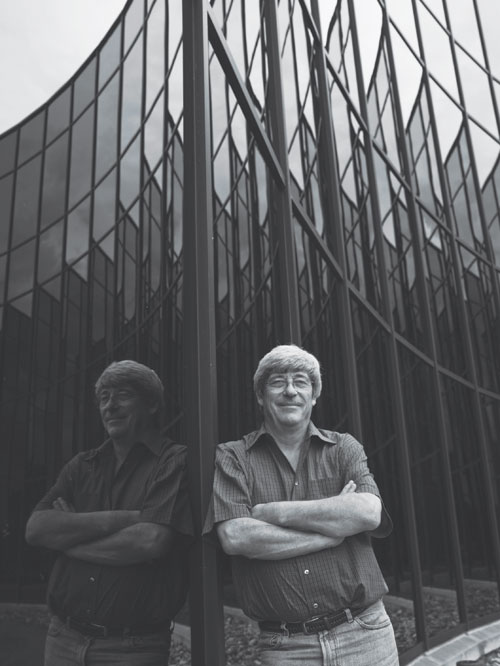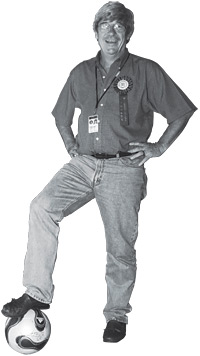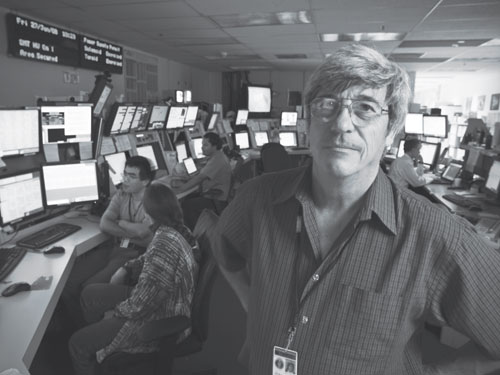JLab s new director
For Hugh Montgomery, the leap from particle physics to nuclear physics is shorter than you might think.
By Tona Kunz
 |
| Photo: Reidar Hahn, Fermilab |
Hugh Montgomery has taken the helm of the Department of Energys Thomas Jefferson National Accelerator Facility in Virginia after almost 25 years at Fermi National Accelerator Laboratory in Illinois. He is JLabs third director, replacing retiring Christoph Leemann.
At Fermilab, Montgomery helped support a number of experiments, including CDF; worked on muon scattering experiments; headed the computing division; helped design the DZero detector upgrade; and most recently served as associate director for research.
He was known for attention to detail and a tireless work ethic, but he didnt have an all-work no-play attitude. The former college soccer player took to the field for years with colleagues in a Fermilab team called Quench and made sure to schedule meetings around time to cheer Manchester United on TV.
Q: You have spent the last 25 years focusing on particle physics and astrophysics research. How do you feel about returning to nuclear physics research, which you did from 197278 at Britains Daresbury Nuclear Physics Laboratory and Rutherford High Energy Laboratory?
A: I dont actually look at this as a transition between particle physics and nuclear physics. I actually look at it as a change from leading one effort to leading another effort.
There are aspects of the [particle physics] work I was doing that turned out to use nuclei and have relevance for nuclear physics.
| (Strong and electroweak forces) The strong interaction holds the subatomic particles of the nucleus together. The electroweak interaction combines electromagnetism and the weak force, which drives radioactive decay and the nuclear reactions that power the sun. |
| (Spectroscopy) In particle physics, the search for composite particles (such as mesons) in order to measure their masses and understand their binding energies. |
| (Superconducting radio frequency technology) The use of super-cold, electrically charged cavities to accelerate particles with great efficiency. |
 |
|
Photo: Reidar Hahn, Fermilab |
| (JLab) One of 10 national laboratories funded by the US Department of Energy Office of Science. Located in Newport News, Virginia, it has 650 employees and focuses on nuclear physics research. |
| (CD-3) The last stage of approval required by the US Department of Energy before construction of a research project can begin. |
The demarcation has changed quite a bit over the last 25 years. In nuclear physics, the scale of experiments you can do allows you to investigate the strong interaction in some detail. Particle physics has tended to drift beyond the strong interaction to focus more closely on electroweak.
Q: What synergies do you view between work at JLab and Fermilab?
A: The distinction between parts of the JLab program and what people call particle physics is fairly narrow; the physics is quite similar.
For example, if you look at some of the work that came out of DZero and CDF in the last few years or out of BaBar and Belle, then you find a fair amount of spectroscopy. One of the new superconducting radio frequency experiments planned for the 12 GeV upgrade at JLab is, in fact, an experiment dedicated to spectroscopy.
There are other areas where there is more emphasis on the structure of the nucleon and of the nucleus, which, once upon a time, was particle physics.
In addition to the physics, over the course of the last few years Fermilab has started to become involved with superconducting radio frequency technology, particularly in respect to the proposed International Linear Collider, but now also Project X. JLab has had SCRF for 20 years and the lab, along with Cornell, is one of the top labs, if not the top lab, for SCRF in this country.
We expect that JLab and its SCRF facilities will play a significant role in several future accelerator projects in the United States, possibly including Project X.
Q: What will you miss most or least about the Midwest?
A: Its cold. Ill certainly notice that difference. Maybe Im getting old and my bones need the warmth. I actually like snow, but preferably with something to slide down.
Q: Is there anything you especially look forward to doing in Virginia?
A: Im a little bit of a deadhead as far as culture and the social life is concerned. If I can get out and ride my bicycle, then that will be fine. On the other hand, maybe I can be a beach bum.
Q: What do you look forward to at JLab?
A: Its an opportunity. Right now, there is always the guy down the hall. I can screw up and he can catch it, or if I am unsure of a decision I should make I can go and ask. At JLab Im the guy sitting at the end of the corridor so it will be my call.
Q: Anything else?
A: Its a users laboratory, like Fermilab, and it has got an experimental program that is vibrant and it has an upgrade that I hope will get DOEs CD-3 approval in a couple of months. This cements its place as the major nuclear user laboratory in the US. When we do experiments there are always surprises. I like to think that physics is experimentally driven. My theory colleagues are extremely important, but most of the fun we have had is when they got it wrong or had not made a prediction before the experimental results appeared.
Q: Just so you can rub it in?
A: Absolutely. Its give and take. Its not as though they are babes in the woods. But, in fact, it is the nature of the science; theory provides an economic description of the experimental fact.
Q: So you like challenges?
A: The extra challenge of being the boss? Yes. Also, just the fact that its different. Ive been in this office for six years, and I tend to think that in a given job six or seven years is about sufficient.
| (Top quark) One of six quarks predicted by current theory. Discovered in 1995 at Fermilab. |
Q: What was it like to be co-spokesman of the DZero experiment in 1994 when evidence for the top quark was found and in 1995 when the discovery was made?
A: That was a ride! I remember we had a week to get the paper together and to get 400-and-odd physicists to say yes. It was tough. We put together a strong group internally that more or less sat continuously for a week and just went over and over the analysis and draft. We had a pretty strong signoff on that.
Q: Did you think you would find the top quark when you started with DZero?
A: My job was to work with Mike Tuts and try and put together a skeleton of a plan for the upgrade for Run II, so I wasnt thinking of this as a particular goal.
Once we started running in 1993, I was involved in the physics of the experiment, but it wasnt something where I had done the planning or set the goals. I was sort of reacting to the opportunity. But it was fun.
Q: What was the highlight of your career at Fermilab?
A: When we did the top quark, that was pretty much the pinnacle. It was pretty hard. You were running on adrenaline for a couple of weeks. I had left CERN because I didnt get a promotion, and when we got the top, I got to give the talk at CERN. That was a nice feeling.
| (DZero and CDF) Particle detector experiments at Fermilabs Tevatron accelerator that explore proton-antiproton collisions. |
Q: How would colleagues at DZero describe you?
A: Youd have to ask them. Darien Wood (current DZero co-spokesperson) once told me I was well-known as the worst-dressed man in DZero. In fact, I got a prize for it.
Q: What did you wear?
A: Mostly shorts and T-shirts.
Q: Tie-dyed T-shirts?
A: I only have a few tie-dyed shirts. I pick up T-shirts at sporting events.
Q: Today you often dress in jeans or business-casual attire and prefer to be addressed as Mont rather than the more high-society nickname Monty. Does that reflect an accessible, everyman approach to management?
A: If thats how I come over, then Im very pleased. But do I set out every morning to behave in a particular way? No. Perhaps I dont stand on ceremony so much. These days, I figure I wear the appropriate attire for the meeting.
Q: Is that attitude an outgrowth of your upbringing in a rural English village that you have described as having 600 people and 600 horses?
A: I guess you could say so. Im an inverted snob. England, when I grew up, was a society that still had class structure. It was a significant component of life and I despised that, because your class is based on your heritage and who your parents are or how much property they owned. That doesnt reflect merit.
| (Higgs boson) Theorized particle that imparts mass to other particles, allowing them to form solid matter rather than float around as light and radiation energy. |
Q: When you started the upgrade to DZero did you contemplate that the experiment would have a chance of discovering the Higgs boson before the Large Hadron Collider did?
A: The Higgs was a long way off at that stage. That was one of the things that was on our minds, but we thought there was a lot of physics to be gotten out of the top quark, and there still is. I would say the top influenced us more in the design than did the Higgs.
| (ATLAS and CMS) Accelerator-based experiments studying proton-proton collisions at the Large Hadron Collider at the European laboratory CERN on the Swiss-French border. |
Q: You worked at CERN and later refereed the ATLAS design proposal and aided Fermilab-based members of the CMS experiment. Yet you also worked at Fermilab on DZero. So who do you want to discover the Higgs?
A: This goes back to the thinking that the ordinary person should be more important than the big, rich guy. Clearly, nothing would give me greater pleasure than to see DZero and CDF get the Higgs.
 |
| Photo: Reidar Hahn, Fermilab |
Click here to download the pdf version of this article.






